A Dynamic Analysis of the Multi-Stack SOFC-CHP System for Power Modulation
Abstract
:1. Introduction
2. Method
2.1. Numerical Modeling of the SOFC Stack
2.2. Numerical Modeling of the Hot Box Components
2.3. MATLAB/Simulink/Thermolib Simulation Procedure
- (a)
- Perform the system design and confirm that the types of components and paths of the fuel, air, and exhaust gas flows are appropriate for thermodynamic equilibrium.
- (b)
- Carry out the modeling of each thermal component and perform simulation test with operating parameters for validation.
- (c)
- Connect the components of the SOFC system to carry out system simulation.
- (d)
- For the dynamic simulation of an SOFC system, the calculation is performed under finite time intervals with specified time steps.
3. Results and Discussions
3.1. Temperature-Dependent System Performance
3.2. Manifold Effect Modification by the Optimal Control Strategy
3.3. Analysis of Long-Term SOFC-CHP Benefits
4. Conclusions
Author Contributions
Funding
Acknowledgments
Conflicts of Interest
Nomenclature
| Open circuit voltage, V | |
| Ohmic impedance, V | |
| Anode activation impedance, V | |
| Cathode activation impedance, V | |
| Anode concentration polarization impedance, V | |
| Cathode concentration polarization impedance, V | |
| R | Gas constant, J⋅K−1⋅mol−1 |
| T | Temperature, K |
| p | Gas pressure, Pa |
| F | Faraday’s constant, C mol−1 |
| ∆h | Reaction enthalpy, |
| Heat capacity of cold gas, kJ⋅kg−1⋅K−1 | |
| Ch | Heat capacity of hot gas, kJ⋅kg−1⋅K−1 |
| Cr | Ratio of heat capacity |
| Cmin | Low values of heat capacities of the hot and cold streams, kJ⋅kg−1⋅K−1 |
| Cmax | High values of heat capacities of the hot and cold streams, kJ⋅kg−1⋅K−1 |
| ε | Effectiveness of heat exchanger |
| qmax | Maximum possible heat transfer rate, kW |
| Th,1 | Hot stream inlet temperature, K |
| Th,2 | Hot stream outlet temperature, K |
| Tc,1 | Cold stream inlet temperature, K |
| Tc,2 | Cold stream outlet temperature, K |
References
- Payne, R.; Love, J.; Kah, M. Generating electricity at 60% electrical efficiency from 1 to 2 kWe SOFC products. ECS Trans. 2009, 25, 231–239. [Google Scholar]
- Massardo, A.F.; Lubelli, F. Internal Reforming Solid Oxide Fuel Cell-Gas Turbine Combined Cycles (IRSOFC-GT): Part A—Cell Model and Cycle Thermodynamic Analysis. J. Eng. Gas Turbines Power 1999, 122, 27–35. [Google Scholar] [CrossRef]
- Van Biert, L.; Woudstra, T.; Godjevac, M.; Visser, K.; Aravind, P. A thermodynamic comparison of solid oxide fuel cell-combined cycles. J. Power Sources 2018, 397, 382–396. [Google Scholar] [CrossRef]
- Araki, T.; Ohba, T.; Takezawa, S.; Onda, K.; Sakaki, Y. Cycle analysis of planar SOFC power generation with serial connection of low and high temperature SOFCs. J. Power Sources 2006, 158, 52–59. [Google Scholar] [CrossRef]
- Mai, B.E. US 20110070509 A1 Fuel Cell System having Two Fuel Cell Stacks Connected in Series. U.S. Patent 9,525,183, 20 December 2016. [Google Scholar]
- Fujita, K.; Seyama, T.; Sobue, T.; Matsuzaki, Y. Development of Segmented-in-series-type Solid Oxide Fuel Cells for Residential Applications. Energy Procedia 2012, 28, 153–161. [Google Scholar] [CrossRef] [Green Version]
- Kupecki, J.; Skrzypkiewicz, M.; Wierzbicki, M.; Stepien, M. Experimental and numerical analysis of a serial connection of two SOFC stacks in a micro-CHP system fed by biogas. Int. J. Hydrog. Energy 2017, 42, 3487–3497. [Google Scholar] [CrossRef]
- Kobayashi, Y.; Ando, Y.; Nishiura, M.; Kishizawa, H.; Iwata, M.; Matake, N.; Tomida, K. Recent Progress of SOFC Combined Cycle System with Segmented-In-Series Tubular Type Cell Stack at MHI. ECS Trans. 2013, 57, 53–60. [Google Scholar] [CrossRef]
- Pirkandi, J.; Ghassemi, M.; Hamedi, M.H.; Mohammadi, R. Electrochemical and thermodynamic modeling of a CHP system using tubular solid oxide fuel cell (SOFC-CHP). J. Clean. Prod. 2012, 29, 151–162. [Google Scholar] [CrossRef]
- Barelli, L.; Bidini, G.; Ottaviano, A. Solid oxide fuel cell modelling: Electrochemical performance and thermal management during load-following operation. Energy 2016, 115, 107–119. [Google Scholar] [CrossRef]
- Kupecki, J. Off-design analysis of a micro-CHP unit with solid oxide fuel cells fed by DME. Int. J. Hydrog. Energy 2015, 40, 12009–12022. [Google Scholar] [CrossRef] [Green Version]
- Fragiacomo, P.; De Lorenzo, G.; Corigliano, O. Performance Analysis of a Solid Oxide Fuel Cell-Gasifier Integrated System in Co-Trigenerative Arrangement. J. Energy Resour. Technol. 2018, 140, 092001. [Google Scholar] [CrossRef]
- Palomba, V.; Prestipino, M.; Galvagno, A. Tri-generation for industrial applications: Development of a simulation model for a gasification-SOFC based system. Int. J. Hydrog. Energy 2017, 42, 27866–27883. [Google Scholar] [CrossRef]
- Corigliano, O.; Florio, G.; Fragiacomo, P. A Performance Analysis of an Anaerobic Digester—High Temperature Fuel Cells Fed by Urban Solid Waste Biogas. Energy Sources Part A Recover. Util. Environ. Eff. 2011, 34, 207–218. [Google Scholar] [CrossRef]
- Fragiacomo, P.; Corigliano, O.; De Lorenzo, G.; Mirandola, F.A. Experimental Activity on a 100-W IT-SOFC Test Bench Fed by Simulated Syngas. J. Energy Eng. 2018, 144, 04018006. [Google Scholar] [CrossRef]
- Ferrari, M.L. Advanced control approach for hybrid systems based on solid oxide fuel cells. Appl. Energy 2015, 145, 364–373. [Google Scholar] [CrossRef]
- Luo, X.; Fong, K. Development of multi-supply-multi-demand control strategy for combined cooling, heating and power system primed with solid oxide fuel cell-gas turbine. Energy Convers. Manag. 2017, 154, 538–561. [Google Scholar] [CrossRef]
- Apfel, H.; Rzepka, M.; Tu, H.; Stimming, U. Thermal start-up behaviour and thermal management of SOFC’s. J. Power Sources 2006, 154, 370–378. [Google Scholar] [CrossRef]
- Wahl, S.; Segarra, A.G.; Horstmann, P.; Carr, M.; Bessler, W.G.; Lapicque, F.; Friedric, K.A. Modeling of a thermally integrated 10 kWe planar solid oxide fuel cell system with anode offgas recycling and internal reforming by discretization in flow direction. J. Power Sources 2015, 279, 656–666. [Google Scholar] [CrossRef] [Green Version]
- Hong, S.K.; Dong, S.K.; Yang, J.B. Experimental and simulated investigation of 1 kW solid oxide fuel cell balance of power system. J. Power Sources 2012, 214, 28–32. [Google Scholar] [CrossRef]
- Aguiar, P.; Adjiman, C.S.; Brandon, N.P. Anode-supported intermediate-temperature direct internal reforming solid oxide fuel cell: II. Model-based dynamic performance and control. J. Power Sources 2005, 147, 136–147. [Google Scholar] [CrossRef]
- Martinez, A.S.; Brouwer, J.; Samuelsen, G.S. Feasibility study for SOFC-GT hybrid locomotive power: Part I. Development of a dynamic 3.5 MW SOFC-GT FORTRAN model. J. Power Sources 2012, 213, 203–217. [Google Scholar] [CrossRef]
- Whiston, M.M.; Bilec, M.M.; Schaefer, L.A. SOFC Stack Model for Integration into a Hybrid System: Stack Response to Control Variables. J. Fuel Cell Sci. Technol. 2015, 12, 031006. [Google Scholar] [CrossRef]
- Pianko-Oprych, P.; Hosseini, S.M. Dynamic Analysis of Load Operations of Two-Stage SOFC Stacks Power Generation System. Energies 2017, 10, 2103. [Google Scholar] [CrossRef]
- Cheng, T.-C.; Huang, T.-Y.; Chen, C.-F.; Tseng, C.-J.; Lee, S.-W.; Chang, J.-K.; Jang, J.S.-C. Analysis of an intermediate-temperature proton-conducting SOFC hybrid system. Int. J. Green Energy 2016, 13, 1649–1656. [Google Scholar] [CrossRef]
- Tanaka, Y.; Terayama, T.; Momma, A.; Kato, T. Numerical Simulation of SOFC System Performance at 90% Fuel Utilization with or without Anode Off-Gas Recycle for Enhancing Efficiency. ECS Trans. 2015, 68, 293–300. [Google Scholar] [CrossRef]
- Chan, S.; Khor, K.; Xia, Z.; Khor, K. A complete polarization model of a solid oxide fuel cell and its sensitivity to the change of cell component thickness. J. Power Sources 2001, 93, 130–140. [Google Scholar] [CrossRef]
- Aguiar, P.; Adjiman, C.; Brandon, N.; Adjiman, C. Anode-supported intermediate temperature direct internal reforming solid oxide fuel cell. I: Model-based steady-state performance. J. Power Sources 2004, 138, 120–136. [Google Scholar] [CrossRef]
- Cui, D.; Liu, L.; Dong, Y.; Cheng, M. Comparison of different current collecting modes of anode supported micro-tubular SOFC through mathematical modeling. J. Power Sources 2007, 174, 246–254. [Google Scholar] [CrossRef]
- Al-Megren, H. Advances in Natural Gas Technology; BoD–Books on Demand: Deutschland, Germany, 2012. [Google Scholar]
- Pianko-Oprych, P.; Jaworski, Z. Numerical investigation of a novel burner to combust anode exhaust gases of SOFC stacks. Pol. J. Chem. Technol. 2017, 19, 20–26. [Google Scholar] [CrossRef] [Green Version]
- Lim, T.-H.; Song, R.-H.; Shin, D.-R.; Yang, J.-I.; Jung, H.; Vinke, I.; Yang, S.-S. Operating characteristics of a 5 kW class anode-supported planar SOFC stack for a fuel cell/gas turbine hybrid system. Int. J. Hydrog. Energy 2008, 33, 1076–1083. [Google Scholar]
- Chang, S.C.; Lin, H.J.; Li, S.W.; Yang, C.H.; Chang, W.S.; Liu, C.R. Analysis of Proton/Oxygen-Ion Conducting Solid Oxide Fuel Cell Systems with an External Reformer. J. Chin. Soc. Mech. Eng. 2017, 38, 597–603. [Google Scholar]
- Zhao, F.; Virkar, A.V. Dependence of polarization in anode-supported solid oxide fuel cells on various cell parameters. J. Power Sources 2005, 141, 79–95. [Google Scholar] [CrossRef]
- Thanomjit, C.; Patcharavorachot, Y.; Ponpesh, P.; Arpornwichanop, A. Thermodynamic analysis of solid oxide fuel cell system using different ethanol reforming processes. Int. J. Hydrog. Energy 2015, 40, 6950–6958. [Google Scholar] [CrossRef]
- Fang, Q.; Blum, L.; Peters, R.; Peksen, M.; Batfalsky, P.; Stolten, D. SOFC stack performance under high fuel utilization. Int. J. Hydrog. Energy 2015, 40, 1128–1136. [Google Scholar] [CrossRef]
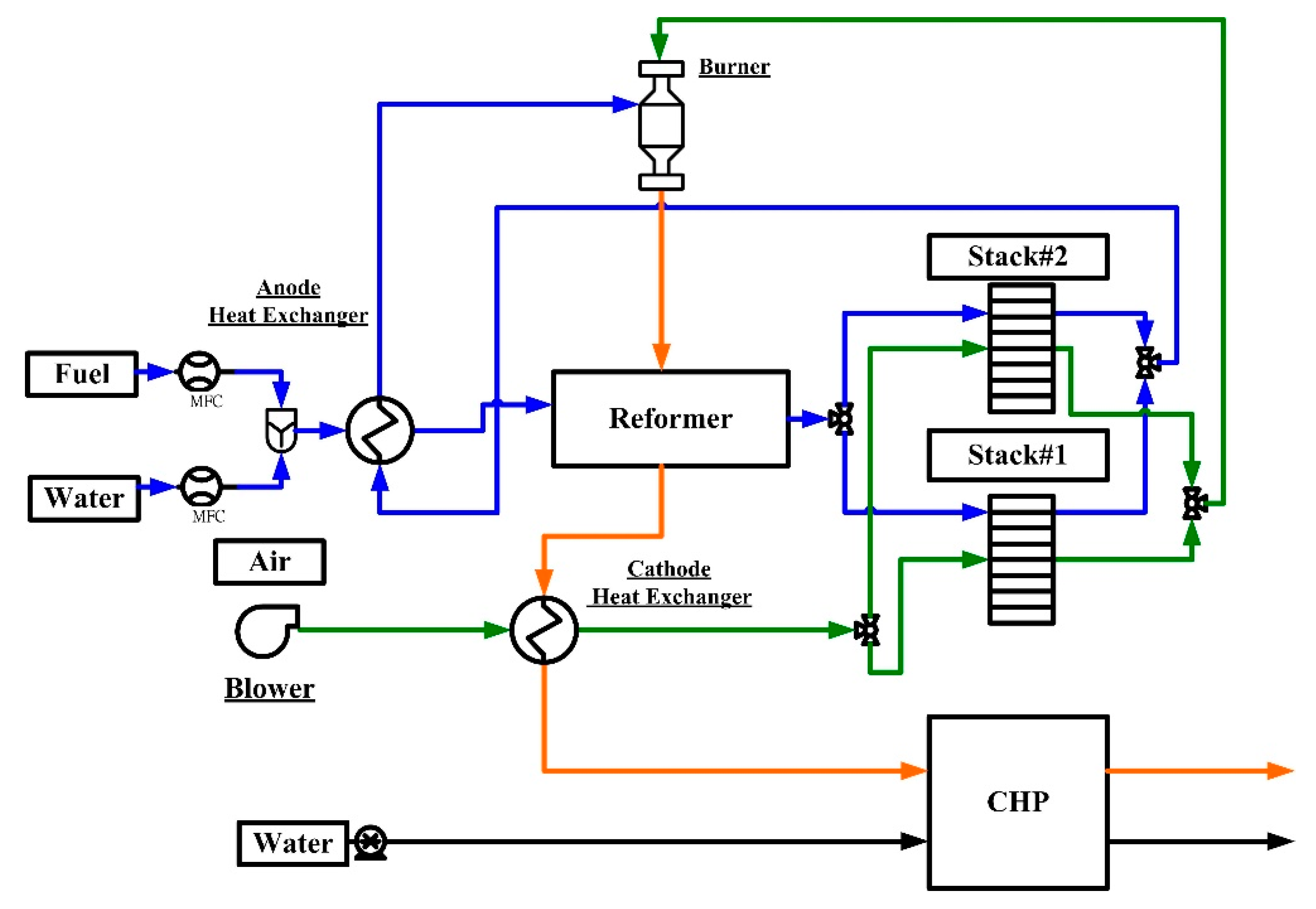
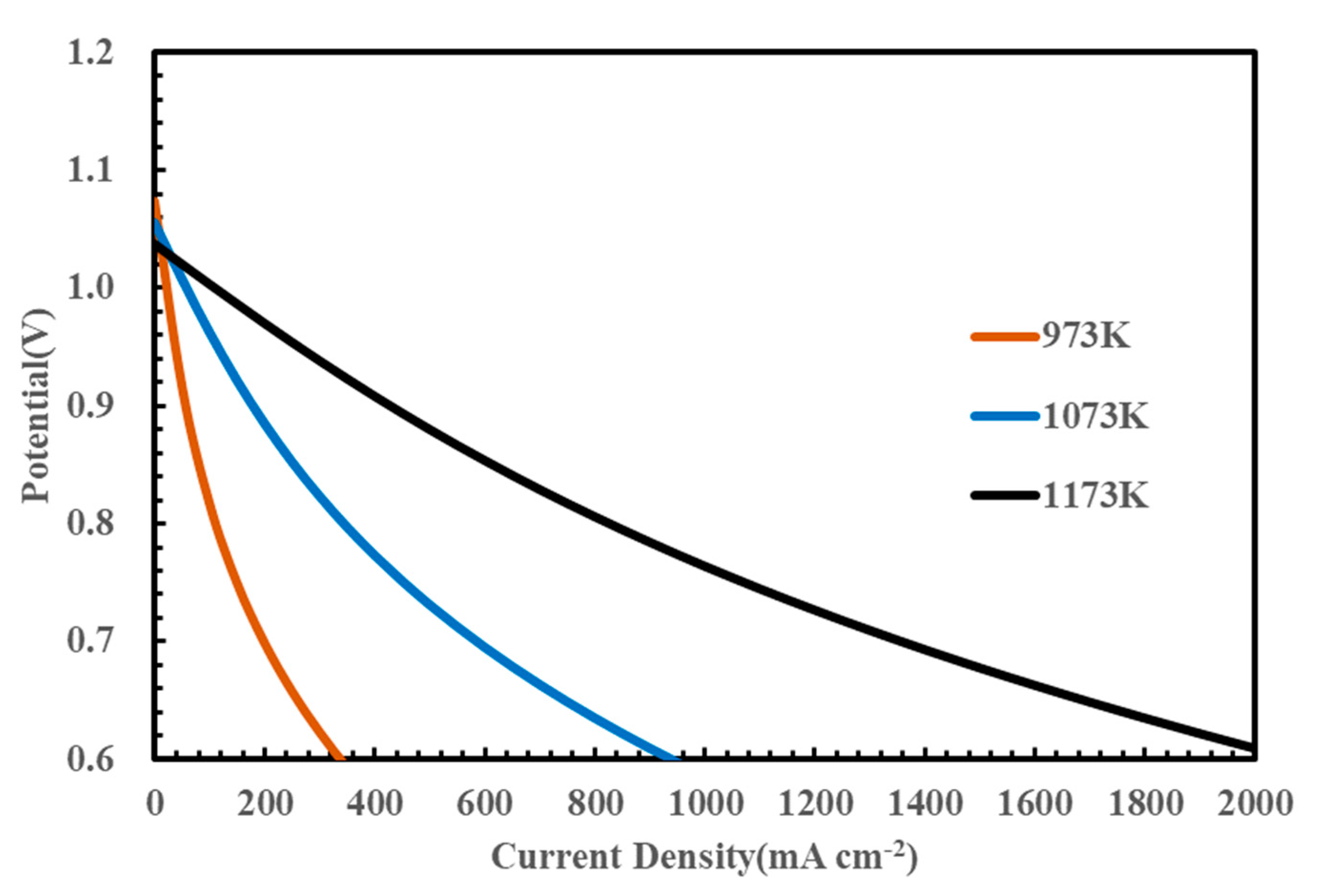
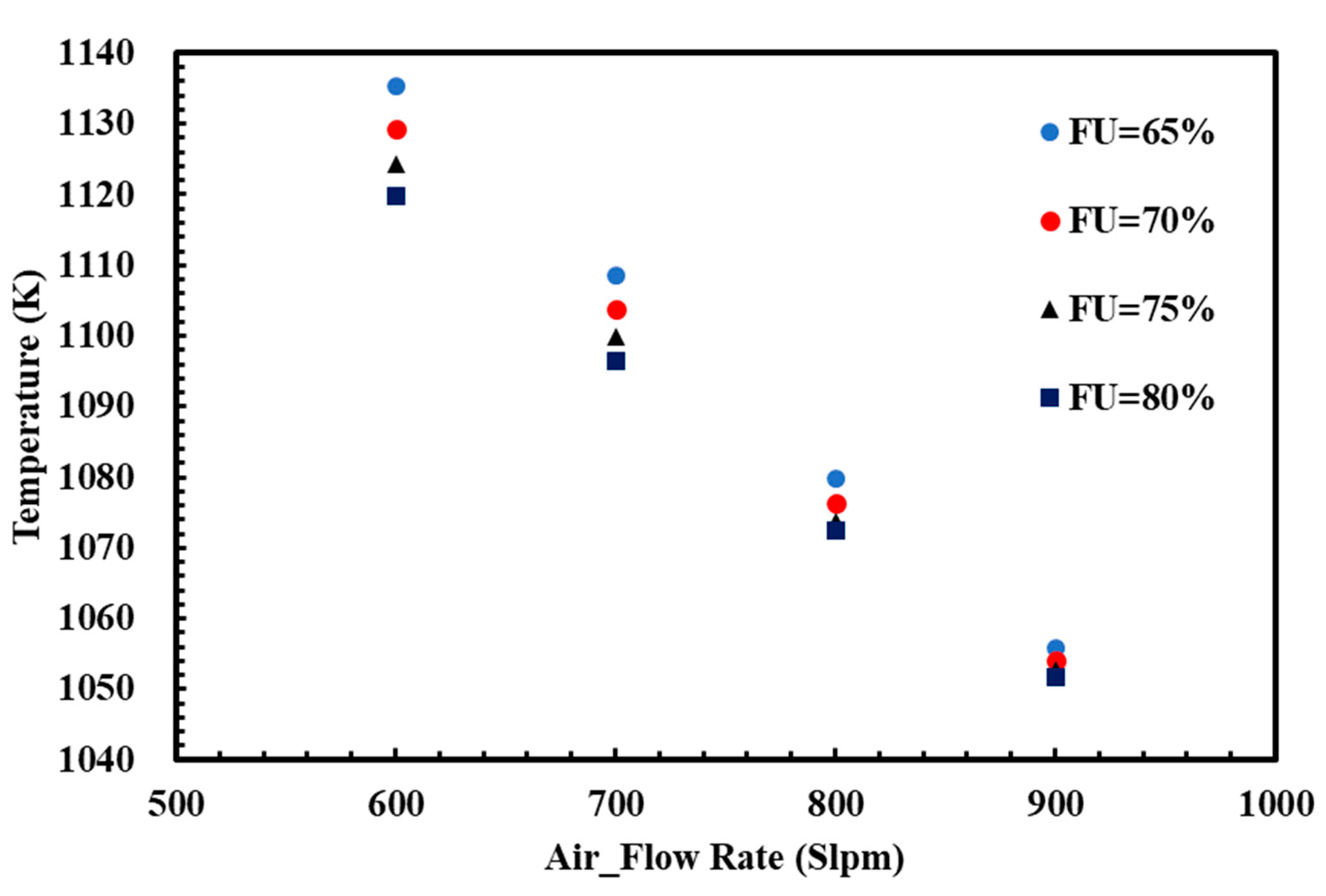

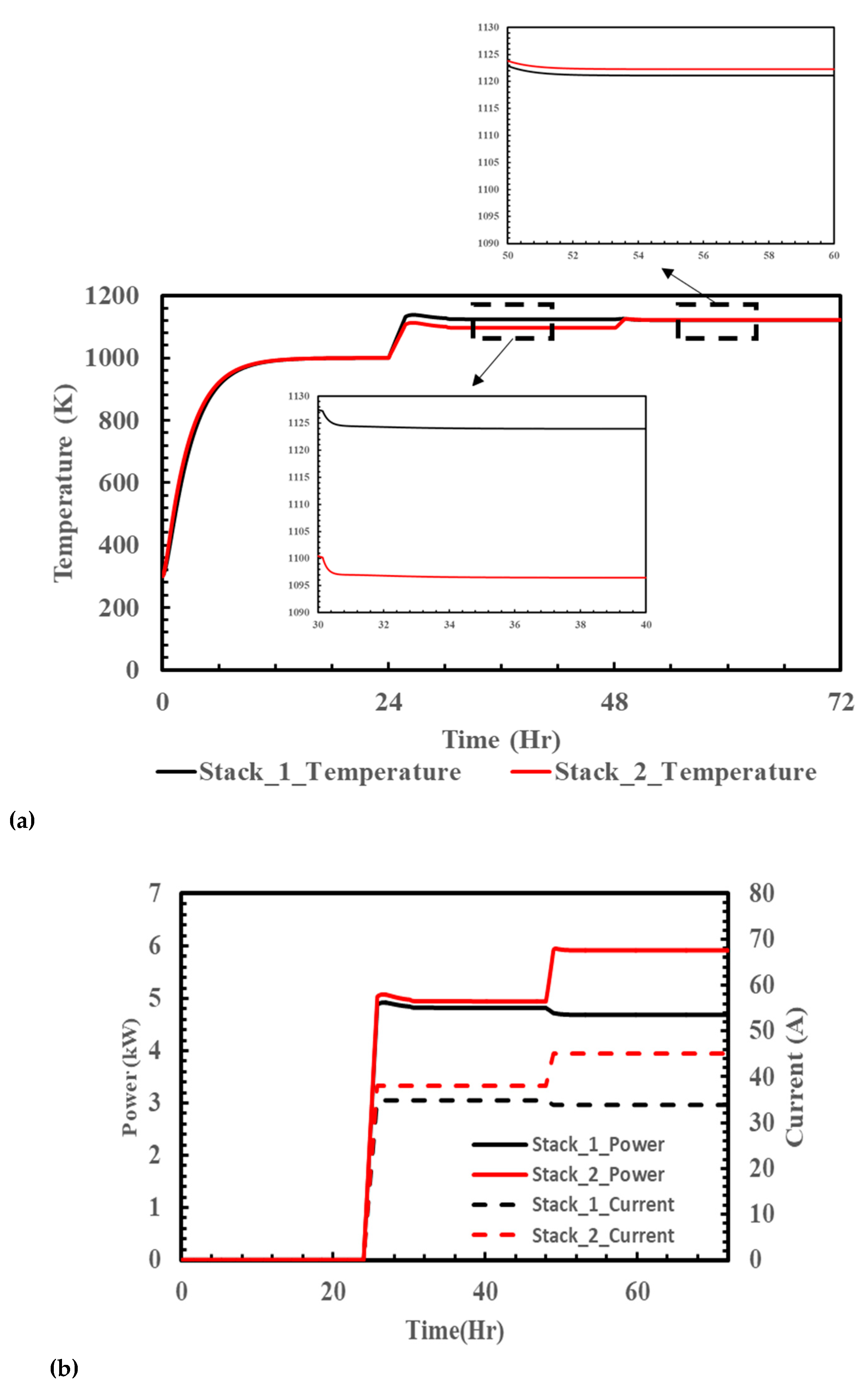
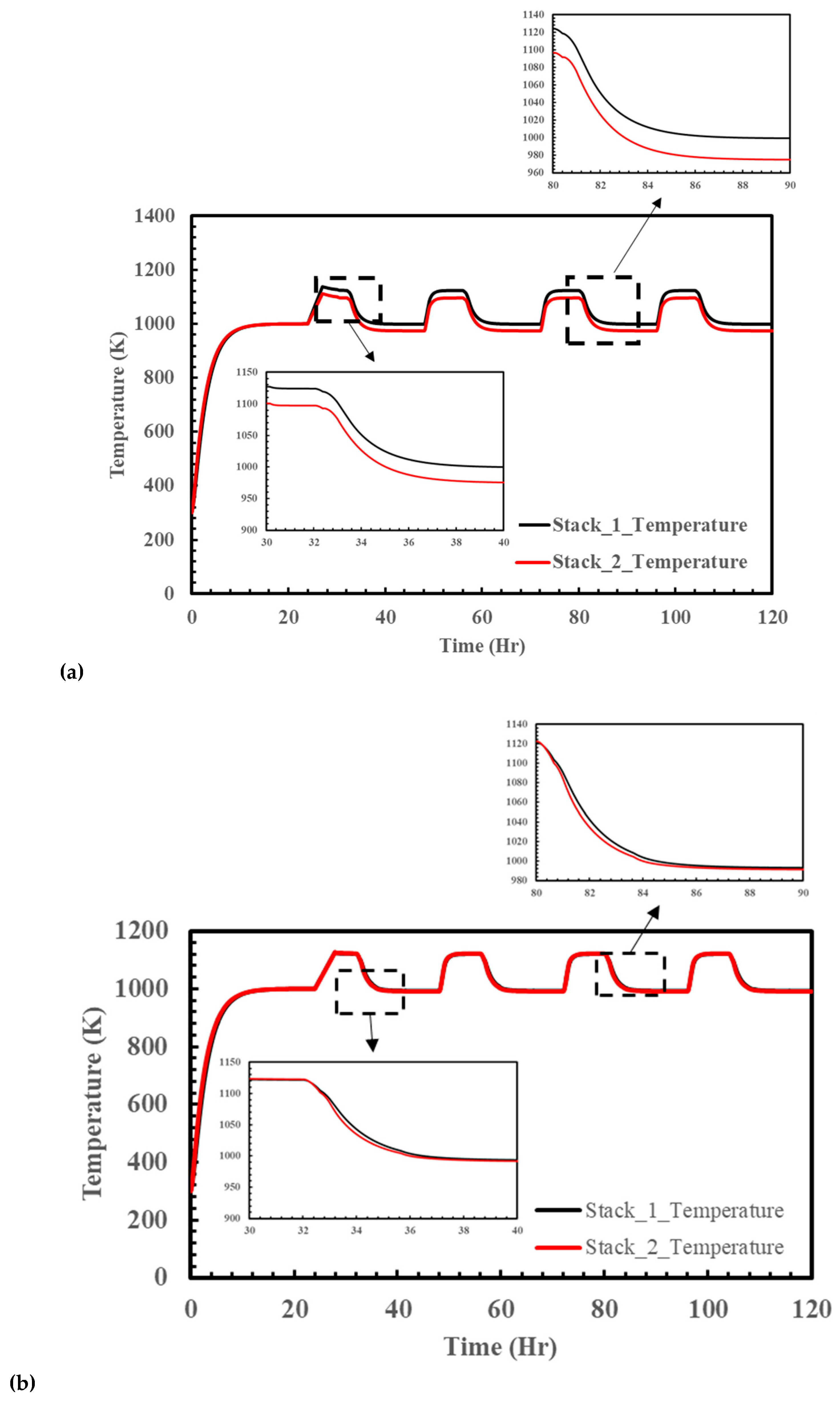
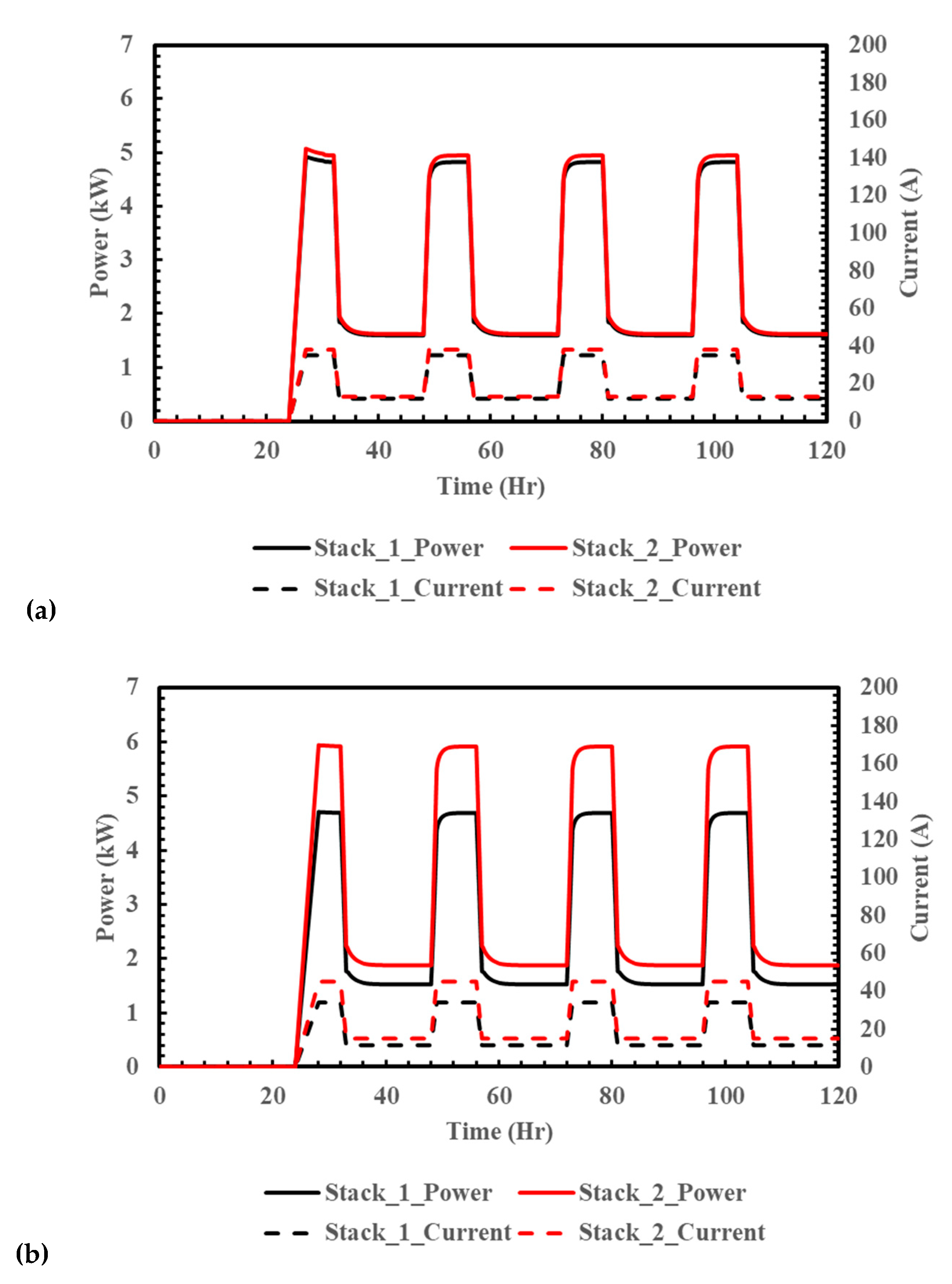
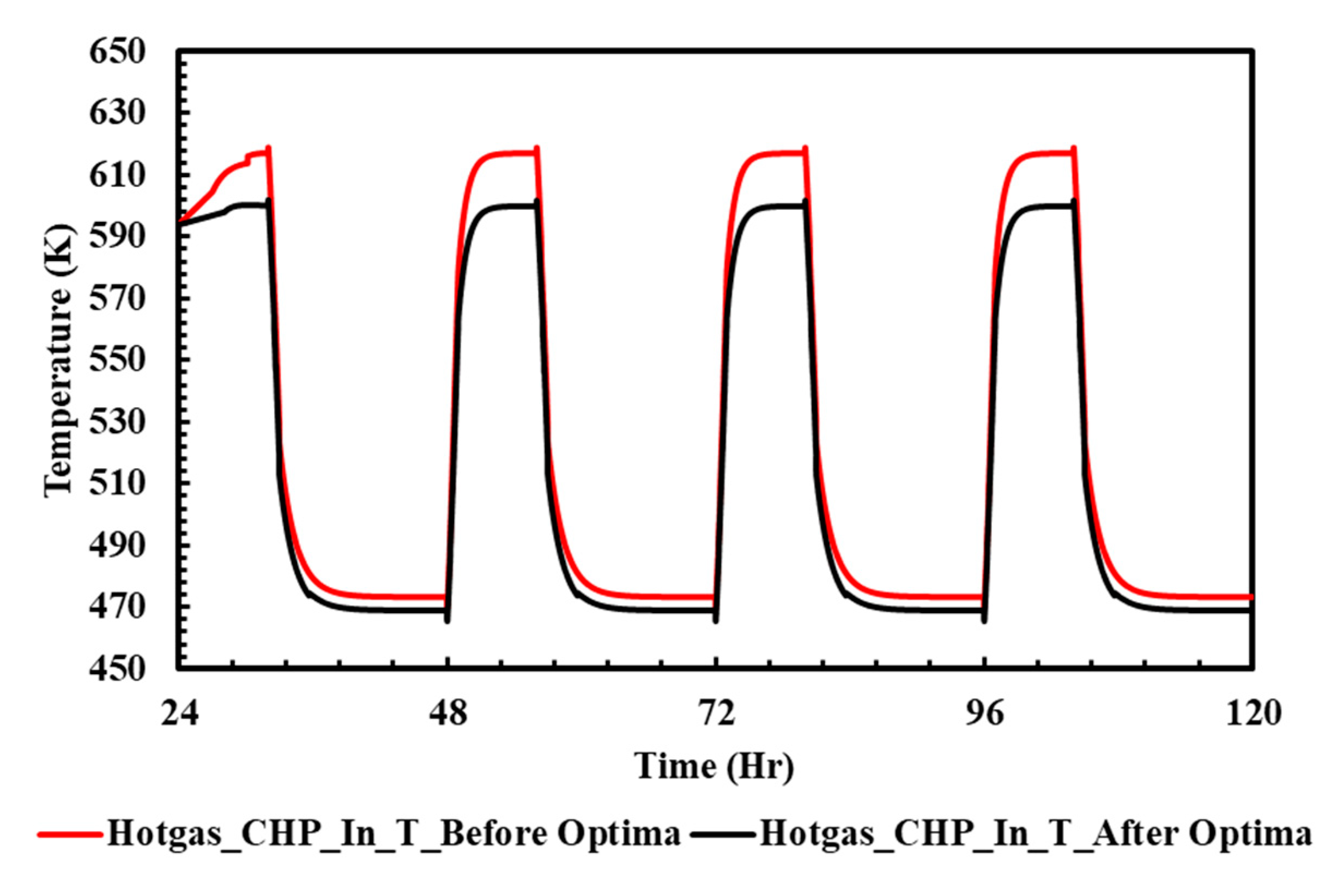
| Parameter | Value |
|---|---|
| Fuel cell operating temperature (°C) | 700, 800, 900 |
| Fuel cell operating pressure (atm) | 1 |
| Electrolyte conductivity (S m−1) [29] | 33.4 × 103 exp(−10.3 × 103/T) |
| Anode conductivity (S m−1) [29] | ((95 × 106)/T) exp(−1150/T) |
| Cathode conductivity (S m−1) [29] | ((42 × 106)/T) exp(−1200/T) |
| Anode apparent diffusion coefficient (m2 s−1) [28] | 3.66 × 10−5 |
| Cathode apparent diffusion coefficient (m2 s−1) [28] | 1.37 × 10−5 |
| Cathode thickness (m) | 12 × 10−6 |
| Electrolyte thickness (m) | 6 × 10−6 |
| Anode thickness (m) | 400 × 10−6 |
| Faraday’s constant (C mol−1) | 96,487 |
| Parameter | Value |
|---|---|
| Number of SOFC stacks in one tower | 2 |
| Activation area of a single cell (cm2) | 100 |
| Number of single cells in a stack | 160 |
| Fuel cell operating pressure (atm) | 1 |
| Temperature where the stack started to produce power (°C) | ≥700 |
| The efficiency of the combustion reaction (%) | 100 |
| The efficiency of the heat exchanger (%) | ≥80% |
| The average heat capacity of methane (kJ/kg·K) | 3.46 |
| The average heat capacity of nitrogen (kJ/kg·K) | 1.11 |
| The average heat capacity of hydrogen (kJ/kg·K) | 14.68 |
| The average heat capacity of carbon monoxide(kJ/kg·K) | 1.13 |
| The average heat capacity of carbon dioxide (kJ/kg·K) | 1.05 |
| The average heat capacity of steam (kJ/kg·K) | 2.111 |
| The average heat capacity of oxygen (kJ/kg·K) | 1.01 |
| The average heat capacity of steel (kJ/kg·K) | 0.45 |
| The average heat capacity of ceramic (Al2O3) (kJ/kg·K) | 0.84 |
| Air Flow/FU | 65% | 70% | 75% | 80% | ||||
|---|---|---|---|---|---|---|---|---|
| Air Flow (slpm) | Power (kW) | I (A) | Power (kW) | I (A) | Power (kW) | I (A) | Power (kW) | I (A) |
| 600 | 5.14 | 37.0 | 5.27 | 38.5 | 5.39 | 40.0 | 5.52 | 41.5 |
| 700 | 4.88 | 36.5 | 5.00 | 38.0 | 5.13 | 39.5 | 5.25 | 41.0 |
| 800 | 4.61 | 36.0 | 4.74 | 37.5 | 4.86 | 39.0 | 4.94 | 40.0 |
| 900 | 4.31 | 35.5 | 4.43 | 37.0 | 4.55 | 38.5 | 4.67 | 40.0 |
| Operating Parameters | Values |
|---|---|
| Number of SOFC stacks in one tower | 2 |
| CH4 for heating process (slpm) | 8 |
| Air for heating process (slpm) | 480 |
| CH4 for loading(slpm) | 36 |
| Steam and Carbon ratio | 2.5 |
| Air for loading (slpm) | 700 |
| Fuel use (%) | 70% |
| The operating temperature for starting the power generation process (°C) | ≥700 |
| The limit of changing the flow rate (slpm/min) | 20 |
| The limit of changing the current (A/min) | 0.16 |
| Cases | Input Fuel | System Efficiency (%) | Power Efficiency (%) | Power Generation (kW) | Heat of CHP Water Output (kW) |
|---|---|---|---|---|---|
| non-modified | full | 85.06 | 49.86 | 9.77 | 6.9 |
| 30% | 90.11 | 49.3 | 3.22 | 2.66 | |
| Optimal control | full | 86.91 | 54.11 | 10.6 | 6.43 |
| 30% | 90.44 | 52.03 | 3.4 | 2.51 |
© 2019 by the authors. Licensee MDPI, Basel, Switzerland. This article is an open access article distributed under the terms and conditions of the Creative Commons Attribution (CC BY) license (http://creativecommons.org/licenses/by/4.0/).
Share and Cite
Yang, C.-H.; Chang, S.-C.; Chan, Y.-H.; Chang, W.-S. A Dynamic Analysis of the Multi-Stack SOFC-CHP System for Power Modulation. Energies 2019, 12, 3686. https://doi.org/10.3390/en12193686
Yang C-H, Chang S-C, Chan Y-H, Chang W-S. A Dynamic Analysis of the Multi-Stack SOFC-CHP System for Power Modulation. Energies. 2019; 12(19):3686. https://doi.org/10.3390/en12193686
Chicago/Turabian StyleYang, Cheng-Hao, Shing-Cheng Chang, Yen-Hsin Chan, and Wen-Sheng Chang. 2019. "A Dynamic Analysis of the Multi-Stack SOFC-CHP System for Power Modulation" Energies 12, no. 19: 3686. https://doi.org/10.3390/en12193686
APA StyleYang, C.-H., Chang, S.-C., Chan, Y.-H., & Chang, W.-S. (2019). A Dynamic Analysis of the Multi-Stack SOFC-CHP System for Power Modulation. Energies, 12(19), 3686. https://doi.org/10.3390/en12193686





